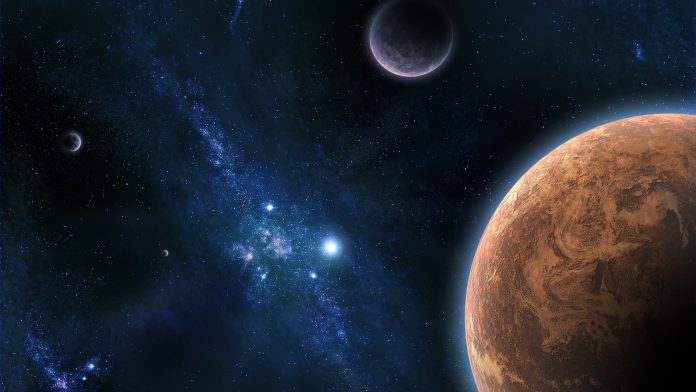Researchers investigate the orbital harmony of TRAPPIST-1 planets in order to detect bombardment phases of their early planetary formation.
In Houston, November 25, seven Earth-sized planets were detected, orbiting the star TRAPPIST-1 in near-perfect harmony. US and European researchers have utilised this harmonic orbit to determine how much physical damage the planets could have withstood during their infancy.
“After rocky planets form, things collide into them,” explained astrophysicist Sean Raymond of the University of Bordeaux in France. “It’s called bombardment, or late accretion, and we care about it, in part, because these impacts can be an important source of water and volatile elements that foster life.”
Bombardment phase of early planetary formation
Raymond teamed up with colleagues from Rice University’s NASA-funded Clever Planets project, alongside seven other institutions, to create a computer model of the bombardment phase of planetary formation in TRAPPIST-1 in order to explore the impacts its planets could have withstood without getting knocked out of harmony. This collaborative team published their findings in a recent study published in Nature Astronomy.
However, “deciphering the impact history of planets is difficult in our solar system and might seem like a hopeless task in systems light-years away,” added Raymond. “On Earth, we can measure certain types of elements and compare them with meteorites. That’s what we do to try to figure out how much stuff bashed into the Earth after it was mostly formed.” But these tools do not currently exist for analysing bombardment effects on exoplanets. “We’ll never get rocks from them, and were not able to observe craters on them, so this is where the importance of the special orbital configuration of TRAPPIST-1 comes in for our research,” said Raymond.
Analysing the special orbital configuration of TRAPPIST-1
TRAPPIST-1 is approximately 40 light-years away from Earth and is far smaller and cooler than our Sun. Its planets are named alphabetically from b to h in order of their distance away from the star. The time needed to complete one orbit around the star, which is the equivalent of one year on Earth, is 1.5 days on planet b and 19 days on planet h. What is remarkable is the orbital harmony that keeps TRAPPIST-1’s Earth-sized worlds from colliding. Their orbital periods form near-perfect ratios, where for every eight ‘years’ on planet b, five pass on planet c, three on planet e and so on.
“We can’t say the exact quantity of what has bashed into any of these planets; however, because of this special resonant configuration, we can put an upper limit on it,” Raymond explained. “It turns out that the upper limit is actually fairly small. We figured out that after these planets have been formed, they weren’t bombarded by more than a very small amount of material. It’s interesting information when we’re thinking about other aspects of the planets in the system.”
Planets grow within protoplanetary disks of gas and dust around newly formed stars. These disks remain for a few million years. Previous research has revealed that resonant chains of planets, such as TRAPPIST-1’s, form when young planets migrate closer to their star before the disk disappears. Computer models have displayed that these disks can shepherd planets into resonance. It’s believed that resonant chains like TRAPPIST-1’s must be set before their disks disappear.
Co-author Andre Izidoro, an astrophysicist and Clever Planets postdoctoral fellow, explained that this information has revealed that TRAPPIST-1’s planets formed fast, in about one-tenth the time it took Earth to form.
Clever Planets research
Clever Planets is exploring the ways planets might acquire the necessary elements to support life. It is led by study co-author Rajdeep Dasgupta, the Maurice Ewing Professor of Earth Systems Science at Rice University. In previous studies, Dasgupta and colleagues at Clever Planets have revealed that a significant portion of Earth’s volatile elements originated from the impact that formed the moon.
“If a planet forms early and it is too small, like the mass of the moon or Mars, it cannot accrete a lot of gas from the disk,” Dasgupta said. “Such a planet also has much less opportunity to gain life-essential volatile elements through late bombardments.” Izidoro said that this would have also been the case for Earth, which gained most of its mass relatively late, including about 1% from impacts after the moon-forming collision.
“We know that Earth had at least one giant impact after the gas (in the protoplanetary disk) was gone, and that was the moon-forming event,” Izidoro clarified. “For the TRAPPIST-1 system, we have these Earth-mass planets that formed early. So, one potential difference, compared to the Earth’s formation, is that they could have, from the beginning, some hydrogen in their atmosphere and have never experienced a late giant impact. This might change a lot of the evolution in terms of the interior of the planet, outgassing, volatile loss and other things that have implications for habitability.”
Raymond explained that this study has implications not only for the analysis of other resonant planetary systems, but for more common exoplanet systems that were once believed to have begun as resonant systems.
“Super-Earths and sub-Neptune’s are very abundant around other stars, and the predominant idea is that they migrated inward during that gas-disk phase and then possibly had a late phase of collisions,” Raymond said. “But during that early phase, where they were migrating inward, we think that they universally had a phase where they were resonant chain structures like TRAPPIST-1. They just didn’t survive; they ended up going unstable later on.”
How the bombardment history of resonant planets can aid future research
Izidoro highlighted that one of the study’s major contributions could come years from now, after NASA’s James Webb Space Telescope, the European Southern Observatory’s extremely large telescope, as well as other instruments that allow astronomers to directly observe exoplanet atmospheres.
“We currently have some constraints on the composition of these planets that form in a resonant migration phase, like how much water they can have,” Izidoro said. In the future, observations will more successfully constrain the interior composition of exoplanets and knowing the late bombardment history of resonant planets could be extremely useful.
“For instance, if one of these planets has a lot of water, such as 20% mass fraction, the water must have been incorporated into the planets early, during the gaseous phase,” Izidoro said. “So you will have to understand what kind of process could bring water to this planet.” This means that orbital harmony can limit the late arrival of water on TRAPPIST-1 planets.









